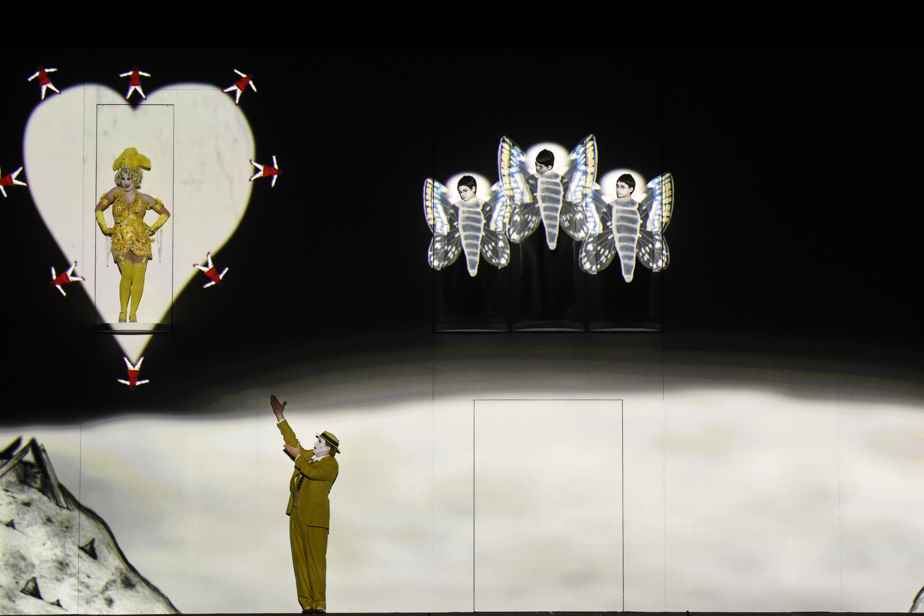Salle Wilfrid-Pelletier was almost full on Saturday evening for the premiere of The Magic Flute of Mozart at the Opéra de Montréal, in a colorful Berlin production. The Press was there.
Posted at 5:00 p.m.
The Opéra de Montréal preferred, during the pandemic, to focus on the webcast of previous productions and on small-scale shows from the Atelier lyrique, unlike other more daring institutions such as the Opéra de Québec or several houses Europeans.
For its return to “grand” opera, after more than two years, the organization had kept in its boxes the project which was initially to be presented in May 2020, a staging created ten years ago for the Opéra comique de Berlin by the British company 1927, whose trademark is to marry animated film and life-size actors.
Who says “1927” says silent cinema, expressionist, in particular. This is where the collective brings us, with a crazy Gothic universe projected on a white screen, the only scenic device of the evening, if not the small glazed cubicles placed on either side of it, where appear the choirs. From this screen emerge, sometimes above, sometimes below, the different protagonists of the opera, who only move in two dimensions.
This superimposition of “real” people on an animated background is reminiscent of the masterpieces of the 1950s and 1960s by Czech filmmaker Karel Zeman. As with the latter, the singers of The flute are not only superimposed on the screen, but interact with the pictorial environment. One thinks of Papageno, invariably followed by his black cat, or of the three Ladies, who amuse themselves by bursting the flying hearts that each lets escape at the sight of a fainted Tamino.
Obviously comes the danger of exaggeration, of overflowing. Tamino constantly trying to dodge the legs of the huge spider depicting the Queen of the Night during the first tune of the latter, it may be too much. Because there is also a text that is said, and this text counts.
When Mozart imposes a spoken text, the staging sums it all up with intertitles in German (translated into the surtitles) while we hear excerpts from fantasies for piano by the same composer. Certain German words present in the animation, however, remain inaccessible to non-German speakers, such as when Sarastro’s gang tries – in vain – to inject “Tugend” (virtue) and “Weisheit” (wisdom) intravenously into the Papageno boor.

PHOTO YVES RENAUD, PROVIDED BY THE PRODUCTION
Richard Sveda in Papagano
The show does, however, have some interesting finds, including transporting Tamino into the belly of the monster from the start of the opera (when he normally only faints at the sight of it) or slapping the Queen of the Night on a card card representing Death. Excellent idea also to lower Tamino underground in a cage of miners with the two armed men in the second act.
Music and voice
The cinema of the 1920s also materializes with the dust on the film, but also with Papageno dressed as a mustard yellow Buster Keaton, with Monostatos disguised as Nosferatu and with the industrial symbolism (many cogwheels) of Metropolis Where Modern times.
There is perhaps however a danger of scattering, of lack of unity, when one falls into the comic strip of the 1950s or Tim Burton. But others may see this eclecticism as a strength.
Ah yes, but there is music too. None of the singers, many of whom have sung this production dozens of times, stands out so much, either positively or negatively, other than Kim-Lillian Strebel’s Pamina, a voice too dramatic for this role, which gives us not too subtle highs.

PHOTO YVES RENAUD, PROVIDED BY THE PRODUCTION
Kim-Lillian Strebel on stage Saturday night
In Papageno, the baritone Richard Sveda may not have the most even voice or the most beautiful legato, but we don’t ask for more to interpret this Boeotian bird-catcher. Christian Zaremba’s Sarastro charms with her Slavic-colored voice, and Anna Siminska has all the notes and power of the Queen of the Night.
Andrea Núñez, Kirsten LeBlanc and Florence Bourget make three effective Dames and Elizabeth Polese is a perfect Papagena, but tenor John Robert Lindsey lacks a bit of projection in Monostatos.
And Tamino? Tenor Sascha Emanuel Kramer, who was fired just before the rehearsal, was replaced in extremis by Brian Wallin, who therefore had to adapt quickly to this very special production. But we see only fire, if not his first tune, whose treble lacked support.
In the pit, at the head of the Orchester Métropolitain, conductor Christopher Allen delivered an ardent Mozart, full of invention.
The opera will be presented again on May 10, 12, 15 and 17.
